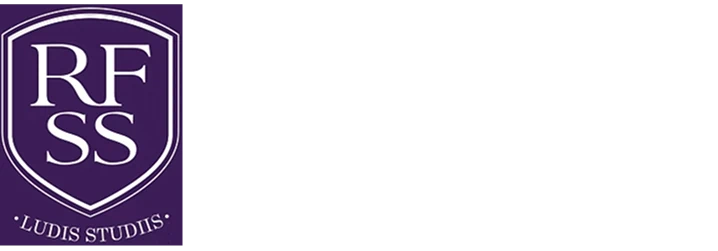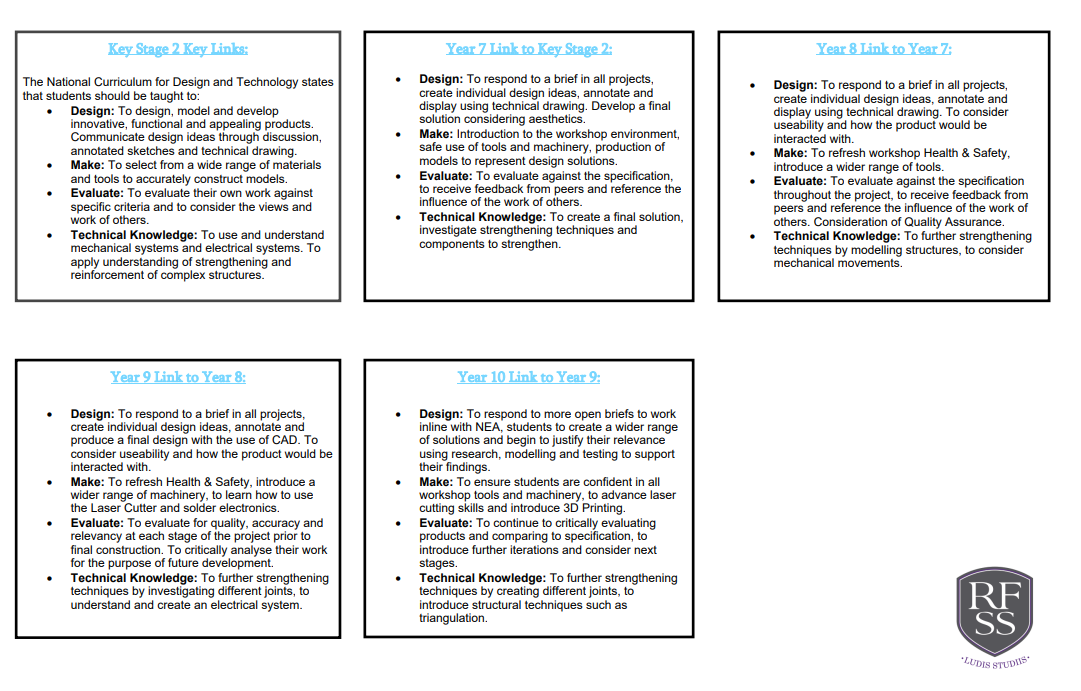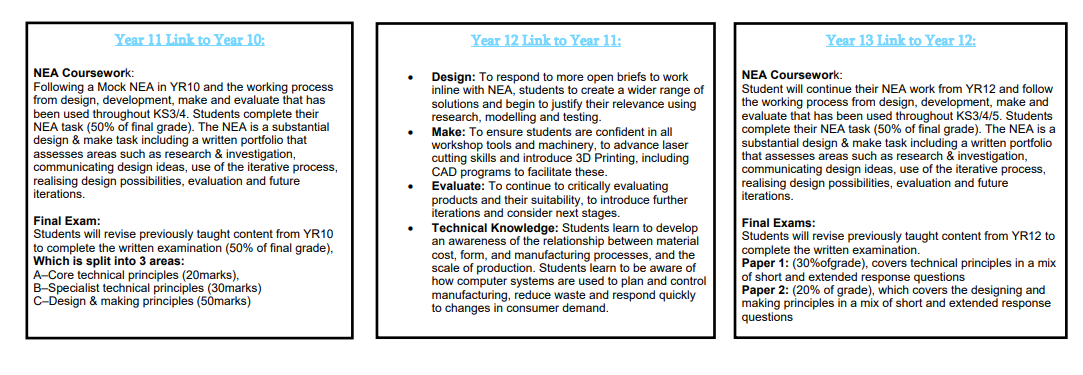Rugby Free Secondary School – Overarching Curriculum Intent (September 2025)
Design & Technology
Curriculum Vision Statement:
To build an inclusive curriculum which is aspirational for all and empowers our students to make outstanding academic and personal progress.
Curriculum Context:
At Rugby Free Secondary School our ambitious curriculum in Design & Technology strives to support students in becoming adaptable and resourceful learners who are independently able to creatively solve problems, offer innovative solutions and produce high quality products and prototypes.
We follow the national curriculum guidelines in Design & Technology to ensure all pupils have the ability to design and create outcomes using the iterative process. Whilst instilling a broad range of transferable skills that will support them as well-rounded individuals.
Design & Technology lessons offer a unique opportunity to combine creativity with analytical thinking. This enables students to design and make products that solve real and relevant problems. Our curriculum promotes cross-curricular learning, integrating and highlighting principles from science, mathematics, computing, and art. Students gain hands-on practical experience with, designing, modelling, tools, processes, and CAD CAM. Students will learn how to; safely and effectively manage risk, evaluate outcomes, and reflect on impact. Each project explores in depth research and appreciation of the work of others, encouraging students to explore the world around them and supporting transition to GCSE.
Curriculum Aims:
Our curriculum aims to:
- Excite and ignite our pupils’ interest in Design & Technology and prepare them to participate in the development of a rapidly changing world.
- To ensure that learners develop technical and practical competencies as well as the wider skills valued by employers.
- To create a curriculum which will engage and challenge students to become self-motivated and confident learners, who can work independently and as part of a team.
- Support pupils in creatively communicating their ideas and designs, focusing on developing oracy within design to allow students fully express themselves.
Curriculum ‘How’:
- Supporting students in building competency in the iterative design process – from research and ideation to prototyping and final production.
- Create opportunities for independent and collaborative problem-solving, challenging students to think critically, investigate the world around them, and develop innovative solutions.
- Foster innovation and originality through open-ended real-world contexts and iterative design.
- Develop evaluative skills – analysing both personal work and engaging with the work of others to inform improvement.
- To support students’ communication of ideas through presentation, positive use of design terminology, group discussion and self-reflection. Promoting a space where students can adapt, change, and collaborate ideas.
- Create a supportive learning environment, adapting to the thinking that design is a cyclic process that is continuously worked at and improved upon.
- Encourage students to bring their ideas to life, utilising their practical skills to create models and prototypes whilst encouraging live problem solving and quality assurance in a supportive environment.
Curriculum ‘What’:
A wide range of practical skills, including:
- Designing
- Modelling
- Tools and Workshop Practice
- Machinery
- Health & Safety
Core knowledge and skills, such as:
- Materials and Properties
- Electronics
- Technical Drawing Skills – Perspective, Isometric, Orthographic, Rendering
- Sketching with annotation and development
Appreciation of the Work of Others:
- Exposure to a range of art movements, craftspeople, and designers — all linked to the GCSE syllabus.
Creative thinking and problem solving:
- Introduction and encouragement of the iterative process
Preparation for KS4:
- Embedding Core knowledge and terminology
- All projects following the GCSE structure, analytical problem solving, real-world scenarios, evaluative and progressive design processes and measurable final outcomes
Curriculum Implementation:
At RFSS the Design & Technology curriculum is collaboratively and coherently planned and sequenced across Years 7- 9/GCSE to ensure that pupils build on all aspects of prior learning and we stretch and challenge all pupils regardless of starting point.
The curriculum has been carefully designed to ensure that it is accessible to and meets the needs of all learners including those with SEND, EAL, or who are disadvantaged. Projects increase in complexity and independence throughout KS3 and onto KS4, with a focus on skill proficiency, design thinking, and real-world application. Assessment is both formative and summative, aligned to clear criteria, feedback and reflection to support growth and progression.
As pupils progress through Key Stage 3, they are given the opportunity to develop skills in using a range of materials and equipment as well as understanding the iterative process of designing and making products. We embed key GCSE terminology from year 7, this supports oracy and allows students to better explain and share their ideas, as well as creating a more seamless transition of students into GCSE.
Year 7 students will receive full Health & Safety training, they will focus on familiarity and independence within the workshop in their timbers project and will receive a CADCAM introduction that covering nets and technical drawing. Year 8 students will build upon their timbers skills by looking at joints and expanding their tools and machinery knowledge. The Year 8 Graphics projects will looking eco-housing, sustainability, and modelling techniques. Year 9 students will refine their timbers skills by taking on more advanced joints, utilise their CADCAM skills, work with the laser cutter and be introduced to electronics.
Curriculum Impact & Outcomes:
The Design & Technology Curriculum at RFSS aims to impact students in the following ways:
- Developing creative and practical skills – promoting independence in workshops and creating transferrable skills.
- Encouraging problem solving and critical thinking – students will learn to consider the needs of the user and offer innovative solutions enhancing their problem-solving abilities.
- Teaching technical and theoretical knowledge – to support understanding of the tools and processes being used and enabling students to make better informed choices and understand how design impacts their lives.
- Curriculum syncing, interconnected, and built on prior knowledge – Identifying to students how each of the cross-curricular subjects (Maths, Science, Computing and Art) fit into Design & Technology to show design as a full process and not individual skills.
- Teamwork and Communication – Encouraging students to share ideas, work together and support each other.
The Design & Technology curriculum aims to support students with following outcomes;
- Understanding of the Design Process resulting in High Quality Prototypes and Products – Students will design and produce functional and appealing products that fully address the given contexts and show a clear understanding of the design process.
- Awareness of key Social Factors and Historic and Cultural Influences – students will be encouraged to consider their environmental responsibility as a designer, promoting responsible innovation. Students will show an appreciation for the work of others and the role key individuals and designs play in society.
- Adaptable and Resourceful Individuals – Students will be given opportunities for personal growth supporting their ability to work with others, confidence to present and defend their design choices. Adaptability in learning new technologies and finding creatives ways to integrate them into their work.


